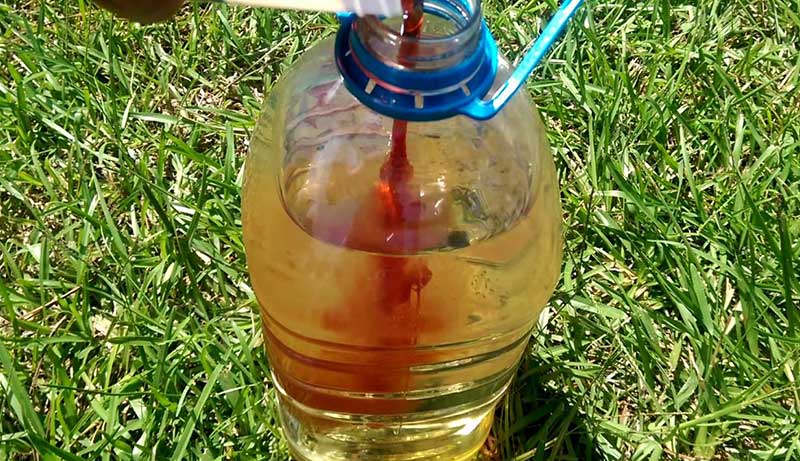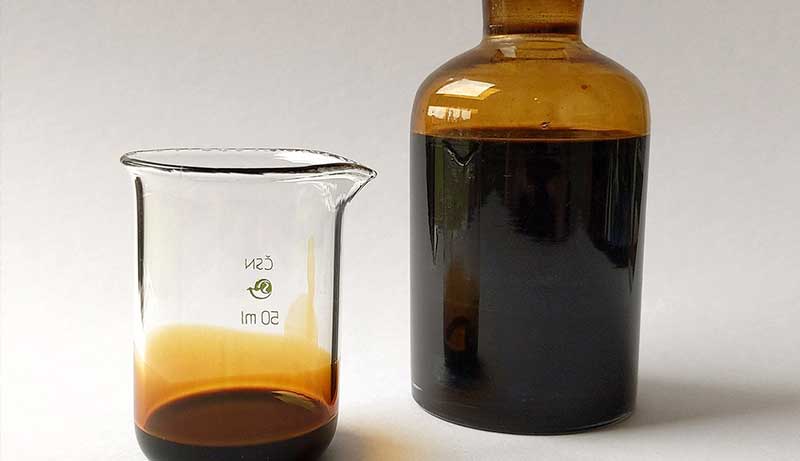If you’re looking to recycle your used motor oil, it’s important to first separate it from any gasoline that may be mixed in. Gasoline and motor oil don’t mix well, so separating them is crucial to the recycling process.
There are a few different ways of how to separate gasoline from motor oil. One common method is to use a funnel and coffee filter. Simply pour the mixture into the funnel and allow the gasoline to drip through the coffee filter into a container. The heavier motor oil will be left behind in the funnel.
Another option is to use a commercial oil separation kit, which can be found at most auto parts stores. These kits usually come with a special container that has a separator pad inside. To use, simply pour the gasoline and oil mixture into the container and allow it to sit for a few minutes. The pad will absorb the gasoline, leaving the motor oil behind.
Once you’ve separated the gasoline from the motor oil, you can proceed with recycling your used oil according to your local regulations. Be sure to dispose of any leftover gasoline properly – never pour it down the drain!
Methods of how to separate gasoline from motor oil?

There are a few methods that can be used to separate gasoline from motor oil. One common method is to use a funnel and gravity to separate the two liquids. Another method is to use an absorption material, such as activated charcoal, to absorb the gasoline from the oil.
Finally, you can use a centrifuge to spin the oil and remove the gasoline from it. Whichever method you choose, make sure that you are working in a well-ventilated area and take all safety precautions when handling these flammable liquids.
Steps of how to separate gasoline from motor oil?

When using a funnel and gravity to separate gasoline from motor oil, you will need:
- A funnel
- A container for the gasoline
- A container for the motor oil
To begin, place the funnel into the container for the gasoline. Slowly pour the motor oil into the funnel, allowing it to flow through into the container below. The heavier motor oil will sink to the bottom of the container, while the lighter gasoline will float on top. Once all of the liquid has been poured through, you can remove the funnel and discard the contents of the containers safely.
If you choose to use an absorption material, such as activated charcoal, you will need:
- A container for the gasoline
- A container for the motor oil
- Activated charcoal
Place a layer of activated charcoal at the bottom of the container for the gasoline. Slowly pour the motor oil into the container, allowing it to flow through the activated charcoal. The activated charcoal will absorb the gasoline from the oil, leaving behind only the motor oil. Once all of the liquid has been poured through, you can remove the activated charcoal and discard it safely.
Finally, if you choose to use a centrifuge to spin the oil and remove the gasoline from it, you will need:
- A centrifuge
- A container for the gasoline
- A container for the motor oil
To begin, place the motor oil into the centrifuge and spin it for a few minutes. This will cause the gasoline to separate from the oil and rise to the top of the container. Once the centrifuge has stopped, you can carefully pour off the gasoline into a separate container, leaving behind only the motor oil. Be sure to dispose of the gasoline safely.
Whichever method you choose, make sure that you are working in a well-ventilated area and take all safety precautions when handling these flammable liquids. Separating gasoline from motor oil is an important process that can help keep your engine running smoothly. With a little care and attention, you can easily do it yourself at home.
Does oil and gasoline mix together?

If you’ve ever been curious about whether oil and gasoline mix together, you’re not alone. It’s a common question, and the answer may surprise you.
Contrary to popular belief, oil and gasoline actually do mix together. However, the proportions that they are mixed in can have a big impact on how well they work together.
When oil and gasoline are mixed in the correct proportions, they create a fuel that is more efficient and effective than either one alone. This is because the oil helps to lubricate the engine, while the gasoline provides the necessary combustion power.
However, if the proportions are off, then the mixture can actually be less effective than either one alone. So it’s important to get the mix just right in order to get the best results.
Fortunately, there are a number of ways to do this. You can either buy premixed fuel, or you can mix your own at home using a simple ratio.
If you’re mixing your own fuel, a good rule of thumb is to mix one part oil to every 200 parts gasoline. This will give you a mixture that is effective and safe for most engines.
Of course, always be sure to consult your owner’s manual before adding any oil or gasoline to your engine. This will help you avoid any potential problems and keep your engine running smoothly for years to come.
So there you have it! Now you know that oil and gasoline do mix together, and you also know how to mix them in the correct proportions. All that’s left to do is put this knowledge into practice and enjoy the benefits of a more efficient and effective fuel mixture.
How can we separate oil from petrol?

There are a few ways to separate oil from petrol. One is by using a process called fractional distillation. This involves heating the mixture until the different components vaporize and then condensing them back into liquids. The different components will have different boiling points, so they can be separated out this way.
Another method is to use adsorption. This is where a substance (usually charcoal) is used to absorb the oil from the mixture. The charcoal can then be removed and the oil can be extracted from it.
Yet another method is to use a centrifuge. This involves spinning the mixture at high speed so that the heavier oil droplets are forced to the outside of the container while the lighter petrol stays in the middle. The oil can then be skimmed off the top.
All of these methods can be used to separate oil from petrol.
Oil and gasoline mixture observation?

Oil and gasoline mixtures can be observed in a variety of ways. The most common method is to use a gas chromatograph, which can give you information about the composition of the mixture.
Another way to observe oil and gasoline mixtures is through mass spectrometry, which can help identify the individual compounds present in the mixture.
Additionally, oil and gasoline mixtures can be observed through refractive index measurements, which can help determine the density of the mixture.
Finally, oil and gasoline mixtures can also be observed through NMR spectroscopy, which can provide information about the chemical structure of the compounds present in the mixture.
Frequently Asked Questions & Answers
1. What is the best way to separate gasoline from motor oil?
The best way to separate gasoline from motor oil is to use a coffee filter or paper towel. Simply pour the mixture into the filter and allow the gas to drain off. Once the gas has drained, you can dispose of it safely.
2. How do I remove all of the gasoline from my motor oil?
You need to make sure that all of the gasoline is removed from your motor oil before you use it in your engine. Gasoline can cause serious damage to your engine, so it’s important to make sure that it’s completely removed before you use your motor oil.
3. Can I reuse motor oil that has been mixed with gasoline?
No, you cannot reuse motor oil that has been mixed with gasoline. Gasoline is highly combustible and can cause serious damage to your engine if it gets mixed in with the oil. Once the two liquids have been mixed, you need to dispose of them safely.
4. What should I do with my motor oil after I’ve removed the gasoline?
Once you’ve removed the gasoline from your motor oil, you can dispose of it safely.
5. Can I use any type of filter to separate gasoline from motor oil?
Yes, you can use any type of filter to separate gasoline from motor oil. Coffee filters and paper towels are both effective at separating the two liquids.
6. How much oil and gasoline do I need to separating?
The amount of oil and gasoline you need to separating will depend on the method you choose. If you only have a small amount of oil and gas to separating, you can use a coffee filter or paper towel. If you have a larger amount of oil and gas to separating, you need to use a more sophisticated method.
7. What is an oil/water separator?
An oil/water separator is a device that will remove the oil from the gas. Once the oil has been removed, you can dispose of it safely.
8. What is a distillation column?
A distillation column is a device that allows you to completely remove the oil from the gas. Once the oil has been removed, you can dispose of it safely.
9. How do I know if all of the gasoline has been removed from my motor oil?
You should always check with your mechanic to make sure that all of the gasoline has been removed from your motor oil before using it in your engine.
10. Will gasoline damage my engine?
Yes, gasoline can cause serious damage to your engine if it gets mixed in with the oil. Gasoline is highly combustible and can damage your engine if it’s not removed properly.
Final Words
The easiest way to separate gasoline from motor oil is to use a paper towel. Simply place the paper towel over the top of the mixture and allow the gasoline to soak into it. Once the gasoline has been absorbed, you can remove the paper towel and dispose of it properly.
You can also use a coffee filter to separate the gasoline from the oil. Simply place the coffee filter over the top of the mixture and allow the gasoline to filter through. Once the gasoline has been filtered, you can remove the coffee filter and dispose of it properly.
Also Read:



